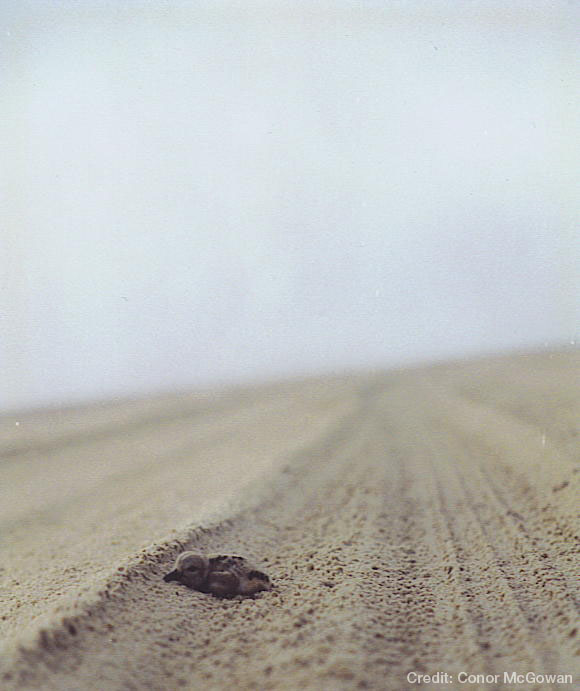Conservation and Management
Author: Brad Winn (BW), Manomet Center for Conservation Science, Manomet, MA.
Effects of Human Activity
The major threat sources recognized for American Oystercatchers are 1) direct loss of habitat from coastal development, 2) disturbance from expanding human recreational activity as a result of coastal development, 3) elevated predation from predator populations augmented by human activities, 4) loss of primary food sources by: pollution, decline in water quality, restricted groundwater flow, disease, and invasive exotic marine organisms, and 5) effects of global climate change, particularly sea level rise eliminating small isolated islands used for nesting and roosting (Schulte et al. 2010).
 Several studies have documented lower nest survival and higher chick mortality in sites of high human disturbance (Novick 1996, Davis 1999, McGowan 2004, Sabine et al. 2005). Oystercatcher pairs also tend to avoid establishing territories and initiating nests in areas with high levels of human disturbance (Davis 1999, C. George pers. Comm.). Habituation to chronic low levels of disturbance in some human dominated landscapes is evident but has not been studied.
Several studies have documented lower nest survival and higher chick mortality in sites of high human disturbance (Novick 1996, Davis 1999, McGowan 2004, Sabine et al. 2005). Oystercatcher pairs also tend to avoid establishing territories and initiating nests in areas with high levels of human disturbance (Davis 1999, C. George pers. Comm.). Habituation to chronic low levels of disturbance in some human dominated landscapes is evident but has not been studied.
Predation is a significant factor limiting reproductive success of oystercatchers (Nol 1989, Novick 1996, Davis 1999, Schulte and Brown 2003, McGowan 2004, Wilke et al. 2007, George et al. 2004, Sabine et al. 2005) (see Demography and Populations). Predator control, especially in isolated habitats such as small barrier islands has increased reproductive success of oystercatchers and other beach-nesting birds. Mammalian predator management (reduction) is responsible for uncharacteristically high AMOY productivity at some Virginia barrier island sites based on annual monitoring data (Alex Wilke, pers. comm.). Other studies have had similar positive results to predator control in many beach-nesting species (Engemen et al. 2010, Nordstom et al. 2003, Martin et al. 2010). In situations of mammalian population expansion into previously unoccupied coastal areas, immediate loss of productivity and long-term decline of pairs and decline in colonies of beach-nesting birds has been documented (Erwin et al. 2001, GADNR unpublished).
Seawater overwash can eliminate seasonal reproductive effort locally or over extensive geographic areas, becoming the most significant factor in lowering reproductive success in some years. Overwash events include boat wakes, normal tidal inundation, and storm driven waters. Flood tides can also temporarily increase predation events by shrinking search area for mammalian predators (BW). However, outside of the breeding season, storms can alter the coastal landscape in beneficial ways creating optimal nesting habitat and reduced predator abundance, resulting in very high productivity. Predator management can mimic this natural phenomenon (Schulte and Simons in review).
Rising sea levels may be having a systemic long-term negative effect on population viability. In some cases however, erosion of upland areas of islands that result in lower profile spits and bars may be temporarily increasing available nesting habitat (Erwin et al. 2010). In other cases, beach rollback that creates wide, wash-over plumes of sand has also increased nesting habitat availability and the number of nesting oystercatcher pairs locally (GADNR unpublished).
Food resources for oystercatchers can be highly ephemeral like the distribution and availability of Dwarf Surf clams (Mulinia lateralis) on the Coast of Georgia, or can be a more reliable resource like oyster beds throughout the bird’s range. The relationship of food availability on density of breeding and wintering oystercatchers is not well known but undoubtedly plays a significant role in density of nesting pairs, reproductive success, recruitment, non-breeding distribution, and annual survival. The effects of compromised water quality including pollution and siltation of coastal waters on oystercatcher food resources and health of the birds is not well known. Baseline health parameters including hematology, plasma biochemistry, hormone levels, combined with heavy metal and pesticide exposure were measured in Georgia and South Carolina and reported by Carlson-Bremmer et al. 2010. Oystercatchers examined in that study were considered healthy, and blood parameters measured will be used as baseline measures for future health assessments of the species.
Management
The following management options (strategies) for population stabilization and recovery have been proposed (Schulte et al. 2010): 1) Identify the most important habitats and food resources used by oystercatchers both temporally and spatially throughout the species range, 2) Recognize emerging alluvial sandbar islands and other new use areas such as washover sand plumes as the sites develop over time or as the birds shift patterns to optimize food and habitat resources, 3) Protect sites by garnering public support and using applicable legal authority, 4) Manage protected areas to reduce or eliminate human disturbance and reduce levels of predation especially before and during the breeding season, 5) Work with the Army Corps of Engineers to create isolated emergent dredge deposit sites while not destroying intertidal shoals and natural inlet function, 6) Promote wide-scale public education efforts through media outlets to promote an appreciation and understanding of oystercatcher biology and conservation need, and 7) Monitor local and range-wide population status and trends to measure effectiveness of management actions.
